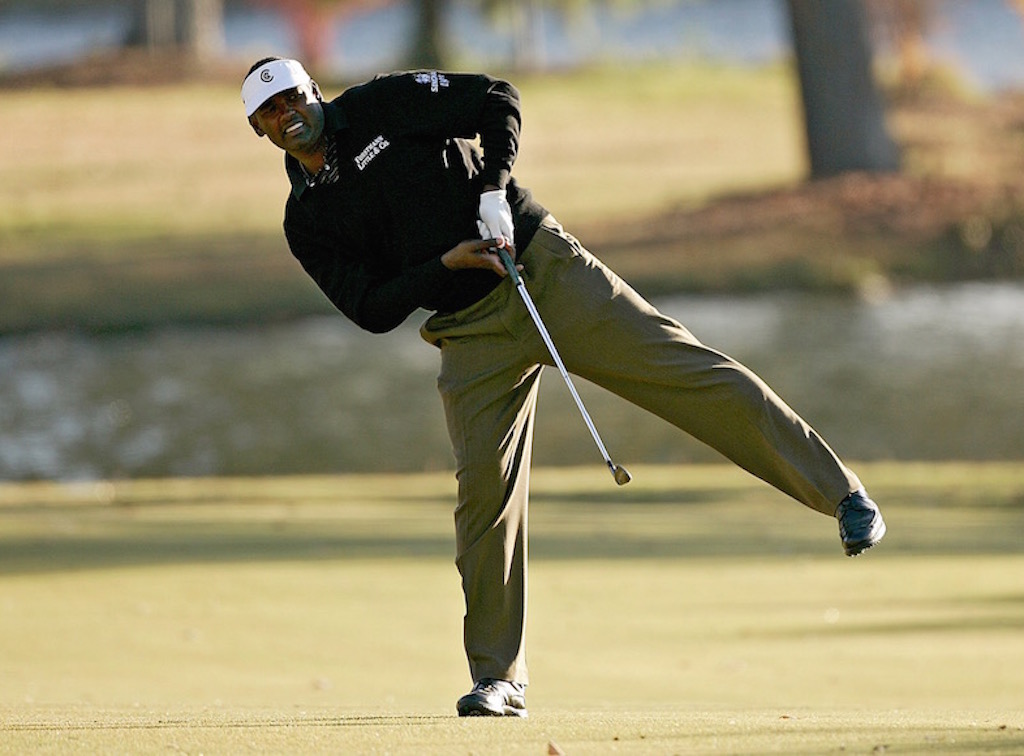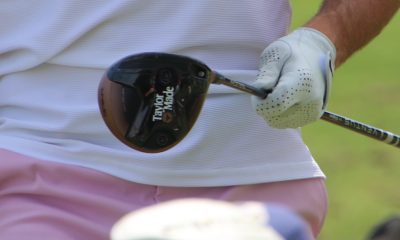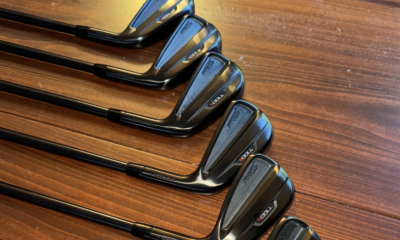Instruction
How good is your balance? Take this test

In your golf swing, maintaining your balance is often the difference between consistency or lack of it. If you are able to maintain good balance, you will have a better chance of being able to make an efficient swing where you can transfer energy more efficiently throughout your body’s different segments. That will help you to generate more speed and more distance.
The bottom line is that without good balance, golfers are relying on compensations from coordination… and a little bit of luck. So the question is, do you feel lucky (punk) or are you going to do something to improve your odds?
Balance is more than a necessary fundamental in our golf swing; it’s a necessary fundamental in life, too. We don’t usually take into consideration that balance is a gift we have earned through evolution, as well as one we have spent our whole lives mastering. What is given can be taken away, however, which means our balance can only be improved or maintained through continual development from challenging it on a regular basis. Routines that aren’t challenging us to maintain our balance will eventually cause it to diminish.
There are three things that we have acquired through evolution that allows us to maintain good balance: our vision, the vestibular system (between our ears), and proprioception. Proprioception is our sense of touch that sends a signal to our brain allowing us to know where we are in space during any given movement. During the golf swing, we use our proprioception sensory receptors located throughout our body to send impulses to our brain to help maintain balance and coordinate a stable movement. We tend to lose our ability to maintain good balance through our adult lifestyles and the aging process, however, which can leave us in a bit of a predicament when we need to rely on our ability to maintain good balance in our golf swing.
In the video below, I share with you a simple test that challenges you to look at just how good your balance is. It also give you some exercises to help you regain good balance if you are lacking the ability to maintain it.
Now that you have tested yourself, how did it go? Was your balance poor? Don’t panic if your balance stinks, because the beautiful thing is that you now have the ability to improve it.
The great thing about finding your weaknesses is that you now know what you have to do to improve, as opposed to wandering around hopelessly unaware that you have poor proprioception. This is great news, but regaining your skills to maintain good balance won’t happen right away. There is no magic snapping of the fingers that will improve your ability to maintain good balance — only good old-fashioned practice.
The two exercises in this video will challenge your balance and help you to regain it, though you have to do them regularly, which means a minimum of three times a week if you want to see any significant improvement. There are actually studies that strongly suggest that for every decade you have lived, you should be challenging your body in all ranges of movement at least once a week. That means, if you are in your 30’s, then three times a week is good. If you’re in your 60’s, though… well, I think you get the picture.
As an added bonus to regaining and training good balance again, you will be regaining improved muscle activation so that you can re-learn how to fire the correct muscles to create stability. In doing so, you will be opening up a whole new cabinet of possibilities such as improved movement and potential power, not to mention reduced chances for injury.
If you’re fighting yourself to maintain your balance, then I guarantee that you are perhaps unknowingly fighting yourself to improve your golf game. And I know that you don’t want to be doing that… I mean, who doesn’t want to improve their game, right? Improving your balance is going to help. You’ll have one less thing to try and coordinate in an already challenging sport.
- LIKE78
- LEGIT6
- WOW1
- LOL1
- IDHT2
- FLOP3
- OB3
- SHANK10
Instruction
The Wedge Guy: The easiest-to-learn golf basic

My golf learning began with this simple fact – if you don’t have a fundamentally sound hold on the golf club, it is practically impossible for your body to execute a fundamentally sound golf swing. I’m still a big believer that the golf swing is much easier to execute if you begin with the proper hold on the club.
As you might imagine, I come into contact with hundreds of golfers of all skill levels. And it is very rare to see a good player with a bad hold on the golf club. There are some exceptions, for sure, but they are very few and very far between, and they typically have beat so many balls with their poor grip that they’ve found a way to work around it.
The reality of biophysics is that the body moves only in certain ways – and the particulars of the way you hold the golf club can totally prevent a sound swing motion that allows the club to release properly through the impact zone. The wonderful thing is that anyone can learn how to put a fundamentally sound hold on the golf club, and you can practice it anywhere your hands are not otherwise engaged, like watching TV or just sitting and relaxing.
Whether you prefer an overlap, interlock or full-finger (not baseball!) grip on the club, the same fundamentals apply. Here are the major grip faults I see most often, in the order of the frequency:
Mis-aligned hands
By this I mean that the palms of the two hands are not parallel to each other. Too many golfers have a weak left hand and strong right, or vice versa. The easiest way to learn how to hold the club with your palms aligned properly is to grip a plain wooden ruler or yardstick. It forces the hands to align properly and shows you how that feels. If you grip and re-grip a yardstick several times, then grip a club, you’ll see that the learning curve is almost immediate.
The position of the grip in the upper/left hand
I also observe many golfers who have the butt of the grip too far into the heel pad of the upper hand (the left hand for right-handed players). It’s amazing how much easier it is to release the club through the ball if even 1/4-1/2″ of the butt is beyond the left heel pad. Try this yourself to see what I mean. Swing the club freely with just your left hand and notice the difference in its release from when you hold it at the end of the grip, versus gripping down even a half inch.
To help you really understand how this works, go to the range and hit shots with your five-iron gripped down a full inch to make the club the same length as your seven-iron. You will probably see an amazing shot shape difference, and likely not see as much distance loss as you would expect.
Too much lower (right) hand on the club
It seems like almost all golfers of 8-10 handicap or higher have the club too far into the palm of the lower hand, because that feels “good” if you are trying to control the path of the clubhead to the ball. But the golf swing is not an effort to hit at the ball – it is a swing of the club. The proper hold on the club has the grip underneath the pad at the base of the fingers. This will likely feel “weak” to you — like you cannot control the club like that. EXACTLY. You should not be trying to control the club with your lower/master hand.
Gripping too tightly
Nearly all golfers hold the club too tightly, which tenses up the forearms and prevents a proper release of the club through impact. In order for the club to move back and through properly, you must feel that the club is controlled by the last three fingers of the upper hand, and the middle two fingers of the lower hand. If you engage your thumbs and forefingers in “holding” the club, the result will almost always be a grip that is too tight. Try this for yourself. Hold the club in your upper hand only, and squeeze firmly with just the last three fingers, with the forefinger and thumb off the club entirely. You have good control, but your forearms are not tense. Then begin to squeeze down with your thumb and forefinger and observe the tensing of the entire forearm. This is the way we are made, so the key to preventing tenseness in the arms is to hold the club very lightly with the “pinchers” — the thumbs and forefingers.
So, those are what I believe are the four fundamentals of a good grip. Anyone can learn them in their home or office very quickly. There is no easier way to improve your ball striking consistency and add distance than giving more attention to the way you hold the golf club.
More from the Wedge Guy
- The Wedge Guy: Golf mastery begins with your wedge game
- The Wedge Guy: Why golf is 20 times harder than brain surgery
- The Wedge Guy: Musings on the golf ball rollback
- LIKE85
- LEGIT13
- WOW6
- LOL1
- IDHT0
- FLOP4
- OB1
- SHANK8
Instruction
Clement: Stop ripping off your swing with this drill!

Not the dreaded headcover under the armpit drill! As if your body is defective and can’t function by itself! Have you seen how incredible the human machine is with all the incredible feats of agility all kinds of athletes are accomplishing? You think your body is so defective (the good Lord is laughing his head off at you) that it needs a headcover tucked under the armpit so you can swing like T-Rex?
- LIKE0
- LEGIT2
- WOW2
- LOL0
- IDHT0
- FLOP0
- OB0
- SHANK2
Instruction
How a towel can fix your golf swing

This is a classic drill that has been used for decades. However, the world of marketed training aids has grown so much during that time that this simple practice has been virtually forgotten. Because why teach people how to play golf using everyday items when you can create and sell a product that reinforces the same thing? Nevertheless, I am here to give you helpful advice without running to the nearest Edwin Watts or adding something to your Amazon cart.
For the “scoring clubs,” having a solid connection between the arms and body during the swing, especially through impact, is paramount to creating long-lasting consistency. And keeping that connection throughout the swing helps rotate the shoulders more to generate more power to help you hit it farther. So, how does this drill work, and what will your game benefit from it? Well, let’s get into it.
Setup
You can use this for basic chip shots up to complete swings. I use this with every club in my bag, up to a 9 or 8-iron. It’s natural to create incrementally more separation between the arms and body as you progress up the set. So doing this with a high iron or a wood is not recommended.
While you set up to hit a ball, simply tuck the towel underneath both armpits. The length of the towel will determine how tight it will be across your chest but don’t make it so loose that it gets in the way of your vision. After both sides are tucked, make some focused swings, keeping both arms firmly connected to the body during the backswing and follow through. (Note: It’s normal to lose connection on your lead arm during your finishing pose.) When you’re ready, put a ball in the way of those swings and get to work.

Get a Better Shoulder Turn
Many of us struggle to have proper shoulder rotation in our golf swing, especially during long layoffs. Making a swing that is all arms and no shoulders is a surefire way to have less control with wedges and less distance with full swings. Notice how I can get in a similar-looking position in both 60° wedge photos. However, one is weak and uncontrollable, while the other is strong and connected. One allows me to use my larger muscles to create my swing, and one doesn’t. The follow-through is another critical point where having a good connection, as well as solid shoulder rotation, is a must. This drill is great for those who tend to have a “chicken wing” form in their lead arm, which happens when it becomes separated from the body through impact.
In full swings, getting your shoulders to rotate in your golf swing is a great way to reinforce proper weight distribution. If your swing is all arms, it’s much harder to get your weight to naturally shift to the inside part of your trail foot in the backswing. Sure, you could make the mistake of “sliding” to get weight on your back foot, but that doesn’t fix the issue. You must turn into your trial leg to generate power. Additionally, look at the difference in separation between my hands and my head in the 8-iron examples. The green picture has more separation and has my hands lower. This will help me lessen my angle of attack and make it easier to hit the inside part of the golf ball, rather than the over-the-top move that the other picture produces.


Stay Better Connected in the Backswing
When you don’t keep everything in your upper body working as one, getting to a good spot at the top of your swing is very hard to do. It would take impeccable timing along with great hand-eye coordination to hit quality shots with any sort of regularity if the arms are working separately from the body.
Notice in the red pictures of both my 60-degree wedge and 8-iron how high my hands are and the fact you can clearly see my shoulder through the gap in my arms. That has happened because the right arm, just above my elbow, has become totally disconnected from my body. That separation causes me to lift my hands as well as lose some of the extension in my left arm. This has been corrected in the green pictures by using this drill to reinforce that connection. It will also make you focus on keeping the lead arm close to your body as well. Because the moment either one loses that relationship, the towel falls.


Conclusion
I have been diligent this year in finding a few drills that target some of the issues that plague my golf game; either by simply forgetting fundamental things or by coming to terms with the faults that have bitten me my whole career. I have found that having a few drills to fall back on to reinforce certain feelings helps me find my game a little easier, and the “towel drill” is most definitely one of them.
- LIKE12
- LEGIT2
- WOW2
- LOL0
- IDHT0
- FLOP2
- OB0
- SHANK8
-

 19th Hole1 week ago
19th Hole1 week agoDave Portnoy places monstrous outright bet for the 2024 Masters
-

 19th Hole2 weeks ago
19th Hole2 weeks agoThings got heated at the Houston Open between Tony Finau and Alejandro Tosti. Here’s why
-

 19th Hole1 week ago
19th Hole1 week agoTiger Woods arrives at 2024 Masters equipped with a putter that may surprise you
-

 19th Hole2 weeks ago
19th Hole2 weeks agoReport: Tiger Woods has ‘eliminated sex’ in preparation for the 2024 Masters
-

 19th Hole3 days ago
19th Hole3 days agoTwo star names reportedly blanked Jon Rahm all week at the Masters
-

 19th Hole2 days ago
19th Hole2 days agoNeal Shipley presser ends in awkward fashion after reporter claims Tiger handed him note on 8th fairway
-

 19th Hole2 weeks ago
19th Hole2 weeks agoAddiction, spinal fusion, and scam artists – Everything Anthony Kim revealed in candid interview with David Feherty
-

 19th Hole2 weeks ago
19th Hole2 weeks agoAnthony Kim says doctors told him that he ‘may not have much time left’ ahead of LIV return

























Ken Kohl
Apr 30, 2018 at 8:01 pm
Good article, thanks for the drills.
Bob Jones
Apr 30, 2018 at 5:02 pm
Especially if you’re somewhat over 50, when balance can no longer be taken for granted.
N
Apr 30, 2018 at 4:49 pm
What defines “losing balance” in this situation? Is it wobbling on one leg with your eyes closed, or is it having to put your other leg down as you have lost all balance?
ogo
Apr 29, 2018 at 7:55 pm
If there is 70 pounds of blubber hanging down in front of you forget balancing on one foot and then the other during the golfswing. Obese men with a pot belly should not be allowed to set foot on a golf course because it could be injurious to their decrepit health. It’s okay to buy PWG clubs, but stay home and don’t make a fool of yourself swinging like a pregnant duck.
Jalan
Apr 29, 2018 at 10:31 pm
Tell that to Craig Stadler, John Daly, even Jason Dufner. Challenge them in a round of golf, and my money is on them.
S
Apr 29, 2018 at 2:58 pm
Smash it and fall back. No need for balance